Unless you’ve been living under a rock, you’ve probably noticed that the term ‘artificial intelligence’ is being thrown around just about everywhere. It has become a major corporate buzzword and hype, especially among digital marketers. Meanwhile half of us still don’t really know what it means or better yet, what it can do for our business. That’s why we’re here to tell you specifically what AI can do for you and how it can make your customer feedback more actionable.
Artificial Intelligence (AI) is essentially a technique used to enable computers to ‘mimic’ human behaviour. Some even see it as synonymous with an exact replica of the human thought process. However, when it is used in marketing we’re not necessarily talking about actual artificial intelligence, but rather applications of the sort, including machine learning and natural language processing.
Why is Artificial Intelligence so popular?
AI presents myriad opportunities for businesses that use large sums of data. Applications such as machine learning, for example, enable businesses to uncover particular insights within their datasets and clearly see patterns in that data. As a result, they can polish up their targeting efforts and deliver more personalised messages, while simultaneously boosting overall customer experience.

This new technology is also changing the market in big ways. In fact, a study carried out by the International Data Corporation has revealed that spending on AI will increase by 50% (between 2016 and 2021) compounded annually. And of the businesses who have already adopted AI in their digital strategies, 83% are already gaining value.
Artificial Intelligence and Customer Feedback
AI technology, in combination with customer feedback, focuses heavily on the analysis of qualitative data (such as open text). In other words, textured and descriptive data that cannot simply be translated into numeric results for quick analysis. This isn’t always clear to some, considering there are plenty of businesses that claim to offer ‘built-in AI technologies’, when really these businesses are just counting flat, quantitative data (such as counting ratings, or low scores for particular browsers) using feedback variables such as URLs and categories – without adding any real ‘intelligence’.
As previously mentioned, machine learning (ML) and natural language processing (NLP) are two most relevant AI technologies in marketing. This applies to customer feedback as well, as both ML and NLP can be used to make feedback analytics actionable.
Machine learning can be used to make predictions based on historical feedback data. This gives marketers good insight into what their visitors may do in the future, whether that’s how likely they are to churn, what they will do next, or even ways to keep the visitor as a loyal customer.
Natural Language Processing is relevant for insights such as the sentiment behind feedback results and grouping strings of text together to quickly uncover patterns and trends within the feedback.
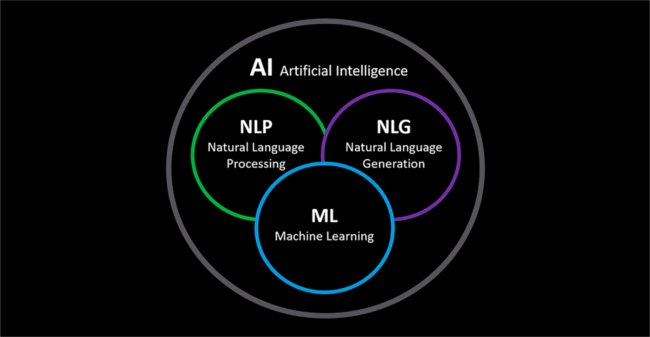
Source: Medium
AI functionalities within the Mopinion software
Mopinion is gearing up to launch several new AI functionalities within the platform. Our goal with these functionalities is to give our users the opportunity to leverage AI for the analysis of their qualitative feedback data (e.g. open comments). In other words, we want to provide them with the technology to extract information and insights from large amounts of text.
In the Mopinion platform, we will offer the following functionalities:
1. Text analytics
Text analytics is the gateway for getting in touch with your customers’ thoughts and feelings in a more intimate manner. With this type of qualitative analysis, you’re not only assessing small-scale issues here and there, but also the entire online customer journey as a whole.
Mopinion gathers and analyses all open comments received from feedback forms on your website or mobile app. With this data, the software can distinguish sentiment, highlight frequently used words (with positive and negative sentiment) as well as look at the correlation of certain words (referred to as word clustering).
Frequency of words (word count)
This is text analytics in its simplest form, whereby the topics are counted and brought to the top based on the frequency with which they are mentioned.


Word grouping (or word pairing)
Often times a group of words can provide you with more insight than just one word alone. For example, the words “costs”, “expensive” and “monthly” are grouped together. With this information, it’s pretty safe to conclude that there are many customers that think the monthly costs for one of your products or services are too expensive. But to take a closer look you can always open the individual comments.
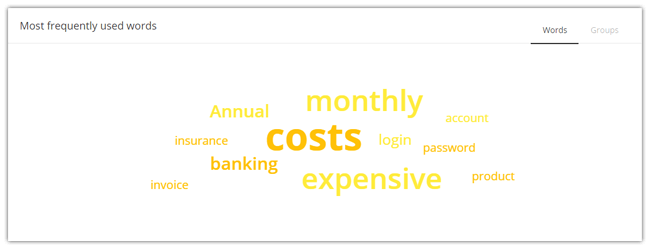
Sentiment analysis
More often than not your customers are going to provide you with feedback on topics they feel strongly about. Text analytics can gauge the severity of the feedback based on positive, negative and neutral word usage as well as the sentiment associated with commonly used words.
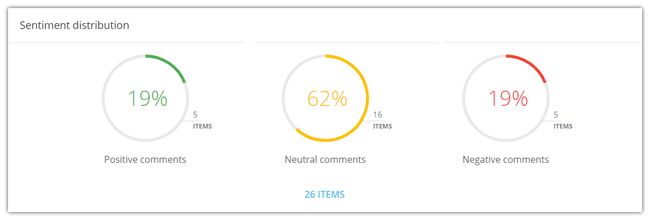
Get more detail…
Want to learn more about why the word ‘banking’ is negative, or why the word ‘login’ keeps getting grouped with the word ‘password’? Users also have the option to click on these items in their dashboard to view the underlying feedback in more detail.
2. Automatic categorisation using Machine Learning
The Mopinion platform currently offers a labeling feature that allows users to label/tag open feedback comments so as to categorise them. For example, the user see the following feedback item, ‘I can’t complete the checkout process’. You could potentially label this with the tags, ‘Product’ and ‘Error’. This is an ideal way of making an increasing pile of customer feedback just a little bit more manageable.
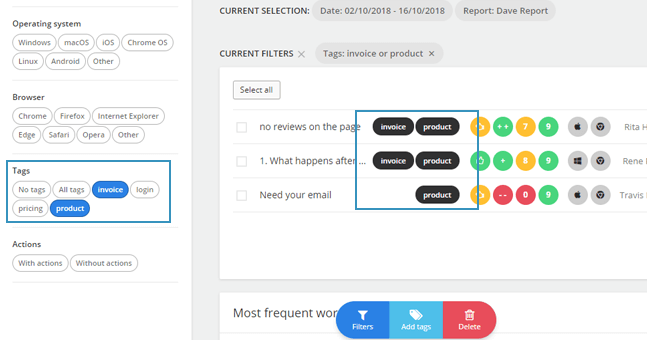
With machine learning, however, we are now able to take this feature one step further. With this technology in place, users who only occasionally label their feedback, for example, can let the system take over, in which case it will categorise items automatically.
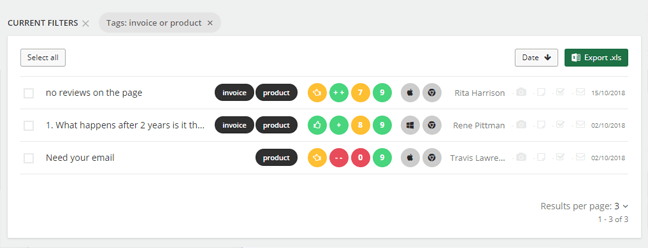
Automatic categorisation can also be completed based on predefined tags. For example, if you add the label ‘invoice’, the system itself will search and find comments that fall under that category, even if the other words or word variations of ‘invoice’ are used.
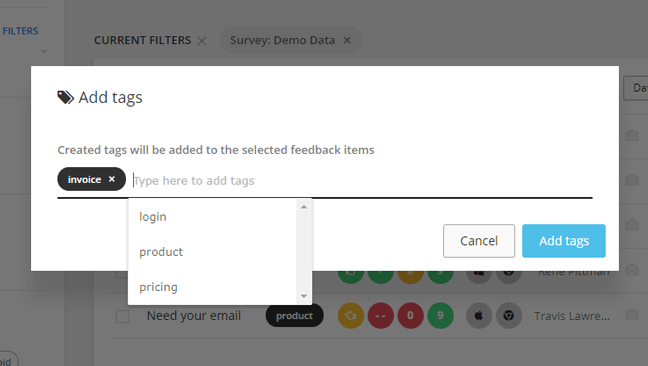
Additionally, if after the system has categorised a feedback item and you find that the item has been incorrectly categorised, you can adjust the label manually and the system will learn from your adjustment and use that information for future categorisations.
This is currently being tested and will be released in November 2018!
3. Insight Feed (Automatic Anomaly Detection)
This is a particularly interesting development we have coming up. Using our anomaly detection algorithm, the system will be able to identify trends and developments and come up with suggestions and insights automatically. These trends are based on all variables of a feedback form, meaning text, scores, metadata, date/time, variables from a data layer (i.e. customer segments) and more.
For example, ‘Customers using Chrome are suddenly more negative about the website than customers using Safari’, or ‘Last week there was considerably more negative feedback from visitors in process x.’
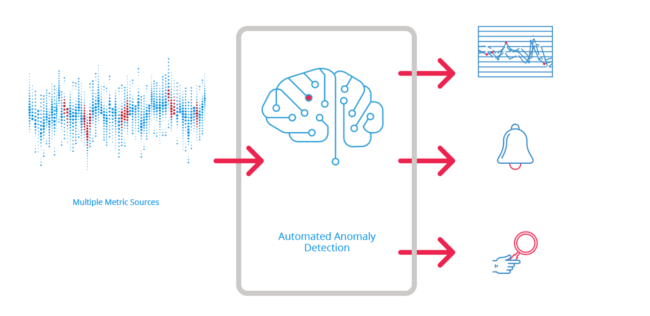
Source: Anodot
This technology is unique in that it does not work with predefined rules or run checks periodically like other tools on the market. For example, most tools have a script running that counts the URLs with the most feedback or the lowest scores every week. While these predefined rules can also be visualised in the Mopinion dashboard and have proven to be very useful, the technique is not considered AI.
Instead this particular Mopinion technology detects these patterns on its own, using a wide array of variables and data combinations, informing you of useful insights when it deems necessary.
With this advanced technology as part of our platform, we are making a real step towards to AI. We hope to release this feature by either the end of Q4 (2018) or the beginning of Q1 (2019).
Coming soon…
Artificial intelligence is certainly an interesting, yet complex development. It is a technology in which we plan to invest heavily as we believe it will help companies get more meaningful and actionable insights from their feedback data.
In fact, that’s what it’s all about, isn’t it? Anyone can create feedback forms and start collecting feedback, but the real challenge lies in extracting the insights. And now with rise of data volumes and the increasing complexity of data on the table, obtaining insights is going to be a challenge that a lot of companies will face…
Stay tuned for more news on Mopinion’s AI developments next week!






